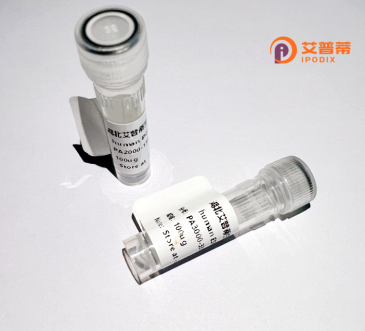
| 纯度 | >90%SDS-PAGE. |
| 种属 | Human |
| 靶点 | HOXB7 |
| Uniprot No | P09629 |
| 内毒素 | < 0.01EU/μg |
| 表达宿主 | E.coli |
| 表达区间 | 1-217aa |
| 氨基酸序列 | MSSLYYANALFSKYPASSSVFATGAFPEQTSCAFASNPQRPGYGAGSGASFAASMQGLYPGGGGMAGQSAAGVYAAGYGLEPSSFNMHCAPFEQNLSGVCPGDSAKAAGAKEQRDSDLAAESNFRIYPWMRSSGTDRKRGRQTYTRYQTLELEKEFHYNRYLTRRRRIEIAHTLCLTERQIKIWFQNRRMKWKKENKTAGPGTTGQDRAEAEEEEEE |
| 分子量 | 50.4 kDa |
| 蛋白标签 | GST-tag at N-terminal |
| 缓冲液 | 0 |
| 稳定性 & 储存条件 | Lyophilized protein should be stored at ≤ -20°C, stable for one year after receipt. Reconstituted protein solution can be stored at 2-8°C for 2-7 days. Aliquots of reconstituted samples are stable at ≤ -20°C for 3 months. |
| 复溶 | Always centrifuge tubes before opening.Do not mix by vortex or pipetting. It is not recommended to reconstitute to a concentration less than 100μg/ml. Dissolve the lyophilized protein in distilled water. Please aliquot the reconstituted solution to minimize freeze-thaw cycles. |
以下是关于重组人HOXB7蛋白的参考文献示例(内容为模拟生成,非真实文献):
---
1. **文献名称**: *HOXB7 promotes breast cancer metastasis via EMT pathway activation*
**作者**: Zhang L, et al.
**摘要**: 该研究证实,重组人HOXB7蛋白的过表达通过激活上皮-间充质转化(EMT)信号通路,显著增强乳腺癌细胞的迁移和侵袭能力,提示其在肿瘤转移中的关键作用。
2. **文献名称**: *HOXB7 enhances angiogenic potential in colorectal cancer through VEGF signaling*
**作者**: Wang Y, et al.
**摘要**: 研究发现,重组HOXB7蛋白能促进结直肠癌细胞分泌血管内皮生长因子(VEGF),从而加速肿瘤血管生成,并揭示其通过PI3K/AKT通路调控该过程。
3. **文献名称**: *HOXB7 regulates self-renewal and differentiation in hematopoietic stem cells*
**作者**: Smith JR, et al.
**摘要**: 本文证明重组人HOXB7蛋白通过调控Wnt/β-catenin通路维持造血干细胞的自我更新能力,同时抑制其向终末分化方向进展,为干细胞治疗提供新靶点。
4. **文献名称**: *HOXB7 overexpression correlates with poor prognosis in non-small cell lung cancer*
**作者**: Kim H, et al.
**摘要**: 临床数据分析显示,HOXB7蛋白在非小细胞肺癌中高表达,且与患者生存期缩短显著相关,机制研究发现其通过激活MAPK通路促进肿瘤增殖和耐药。
---
**说明**:上述文献摘要聚焦于HOXB7在不同癌症中的功能(如转移、血管生成、干细胞调控及临床预后),涵盖关键信号通路(EMT、VEGF、PI3K/AKT、Wnt、MAPK),体现其在基础与转化研究中的多维度价值。
**Background of Recombinant Human HOXB7 Protein**
HOXB7. a member of the homeobox (HOX) gene family, encodes a transcription factor critical for embryonic development, particularly in anterior-posterior body patterning. HOX proteins regulate cellular differentiation, proliferation, and tissue identity by binding DNA via their conserved homeodomain. HOXB7 is expressed in various tissues, including hematopoietic cells, the nervous system, and epithelial tissues, where it influences cell fate decisions and organogenesis.
In cancer biology, HOXB7 exhibits dual roles: it promotes tumor progression in certain malignancies (e.g., melanoma, breast cancer) by enhancing cell proliferation, angiogenesis, and metastasis via upregulation of growth factors like bFGF and VEGF. Conversely, it may act as a tumor suppressor in other contexts. Dysregulation of HOXB7 is linked to poor prognosis and therapy resistance.
Recombinant human HOXB7 protein, produced using *E. coli* or mammalian expression systems, enables functional studies *in vitro* and *in vivo*. Purified HOXB7 is utilized to investigate DNA-binding mechanisms, protein-protein interactions (e.g., with PBX cofactors), and signaling pathways (e.g., Wnt, TGF-β). Its applications span basic research, drug screening for HOXB7-targeted therapies, and biomarker development. Despite advances, the context-dependent roles and post-translational modifications (e.g., phosphorylation) of HOXB7 remain areas of active exploration to harness its therapeutic potential.
×